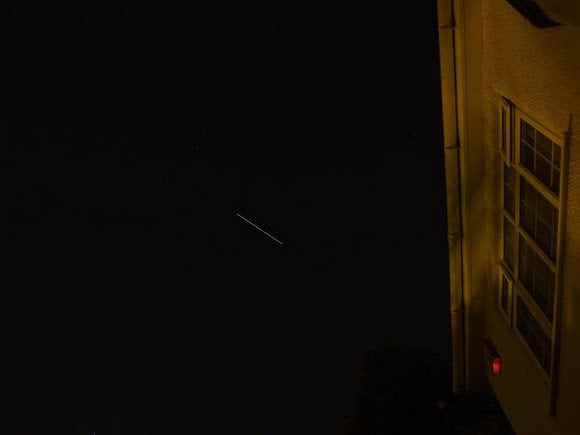[/caption] As I write this, astronauts from space shuttle Discovery are on the first spacewalk of the STS-119 mission, installing the fourth and final set of solar array wings to the International Space Station. Once the array is deployed, the station will surpass Venus as the brightest object in the night sky, second only to the Moon. This week provides great sighting opportunities for North America and Europe to watch the station/shuttle complex as it passes overhead. You might even be able to take a picture of the event, like
Tim Lovell
did, who lives in the UK. Tim took this image just a short time ago, on March 19, 2009 at about 21:00 CET . If you've never had the opportunity to see the space station fly over your backyard, this is a great chance to do so. And for those of you that have seen the ISS before, you know what a spectacular (and sometimes spine-tingling) sight it is. And now that the station is growing (and while the shuttle is docked) the ISS will be brighter than ever. How can you find out when the station will be flying over your house?
There are a couple of different websites that provide real-time tracking data and information about the ISS sighting opportunities. NASA has a
Quick and Easy Sightings by City site
, where you just search for your country and city which provides local times and the location in the sky where the station will be visible.
The European Space Agency also provides their ISS: Where Is It Now site that also allows you to select your country and city to find the station's location.
The
Heaven's Above website
(which also powers ESA's site) is also an excellent site to find out when the ISS, as well as all sorts of other satellites and other heavenly sights will be visible. At Heaven's Above, you can plug in your exact latitude and longitude, so if you live in a remote area, you'll be able to have exact times and locations to look for satellites instead of relying on information for the nearest city.
So take this great chance to see our orbiting outpost. If you have a strong enough and tracking-capable telescope you might even be able to spot specific modules on the station, or the solar arrays.
The solar array truss segment, known as Starboard 6 or S6 for short, weighs 14,000 kilograms (31,060 pounds) and measures 5 meters (16.3 feet) wide, 13.8 meters (45.4 feet) long in the shuttle's cargo bay. Once deployed, the ISS will then have four panels on each end of its power truss. Total surface area of all the arrays will be roughly one acre, generating 84 to 120 kilowatts of useable power, depending on the time of year and angle to the sun.
Thanks to Tim Lovell for sharing his ISS image!
 Universe Today
Universe Today
